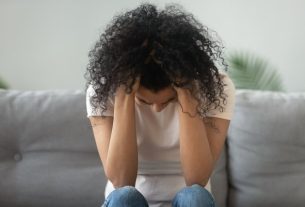Estrogen is one of the main sexual hormones in women, being responsible for the development of physical characteristics and female sexual organs. This hormone is produced mainly in the ovaries, adrenal glands and adipose tissue.
In men, estrogen is also produced in small quantities by the testicles, performing important functions in the male reproductive system, such as regulating libido, erectile function and sperm production.
Changes in estrogen levels may indicate problems such as ovarian failure or hypogonadism, and it is recommended to consult an endocrinologist, gynecologist, for women, or urologist, in the case of men, to confirm the diagnosis and start the most appropriate treatment.

Main functions
The main functions of estrogen are:
- Regulate a woman’s reproductive cyclestimulating the development of the uterus;
- Stimulate the development of breasts and female sexual organsespecially during puberty;
- Promote egg maturationbefore its release;
- Promote growth, maturation and bone healthprotecting against the development of osteoporosis;
- Increase the accumulation of fat in some parts of the bodysuch as glutes and thighs, which are characteristic of female appearance;
- Improve the appearance of the skinwhich tends to be softer and smoother in women;
- Regulate the amount of water and minerals in the bodyespecially in pregnancy, causing sodium and water retention.
Furthermore, in men, estrogen also participates in the regulation of libido, erectile function and sperm production, as well as bone health and fat and carbohydrate metabolism.
Where is it produced
In women, estrogen is produced mainly by the ovaries, and is also produced in smaller quantities in the adrenal glands and adipose tissue. Furthermore, during pregnancy, this hormone is also produced by the placenta.
In men, estrogen is produced especially by the testicles, bone cells, adipose tissue and adrenal glands, although in much smaller quantities than in women.
In addition to production by the body, some foods can be a source of estrogens, known as phytoestrogens or natural estrogens, such as soy, flaxseed, yam or blackberries, and increase the amount of estrogen in the body. See the main foods rich in phytoestrogens.
Types of estrogens
The main types of estrogen produced are:
Estrone (E1)
Estrone is produced by the ovaries, adipose tissue and adrenal glands and, although it is less “potent” than other estrogens, it is the main type produced in women after menopause. See what estrone is and what it is for.
Estradiol (E2)
Estradiol is produced mainly in the ovaries and is the most “potent” estrogen, being found in higher levels in women of childbearing age and who are not pregnant.
This estrogen plays a fundamental role in sexual development, varying its levels throughout the menstrual cycle. After menopause, it has a lower but constant concentration. Understand better what estradiol is and its functions.
Estriol (E3)
Estriol is a type of estrogen produced especially during pregnancy by the placenta. This estrogen promotes the growth of the uterus and gradually prepares the woman’s body for childbirth and breastfeeding.
Relationship between estrogen and progesterone
Estrogen and progesterone are the most important female hormones. Both are produced in the ovary and, together, control the menstrual cycle, showing an increase or decrease in concentration according to the phase of the cycle.
In the ovulatory phase of the menstrual cycle, the estrogen level reaches its peak and progesterone is barely produced after ovulation.
After ovulation, it is possible to notice an increase in the production of estrogen and, mainly, progesterone, which act to prepare the uterine lining for possible implantation of the embryo in the event of pregnancy. Better understand the phases of the menstrual cycle.
Reference values
The amount of estrogen in the body is mainly measured by the amount of estradiol in the blood. While in men the estradiol value considered normal is 20.0 to 52.0 pg/mL, in women, its value can vary according to the menstrual cycle:
- Follicular phase: 1.3 to 266.0 pg/mL
- Mid-menstrual cycle: 49.0 to 450.0 pg/mL
- Luteal phase: 26.0 to 165.0 pg/mL
- Menopause: 10 to 50,0 pg/mL
- Menopause treated with hormone replacement: 10.0 to 93.0 pg/mL
In case of changes in estrogen levels, it is recommended to consult an endocrinologist, gynecologist, for women, or urologist, in the case of men, for an evaluation.
If you want to make an appointment, you can find the endocrinologist closest to you using the tool below:
Taking care of your health has never been easier!
The doctor may also recommend other tests, such as measuring the hormones LH and FSH in the blood and abdominal ultrasound, to identify the cause of the changes and indicate the most appropriate treatment.
What can be high estrogen?
High estrogen can be caused by precocious puberty, perimenopause, polycystic ovary syndrome, pregnancy and the presence of a tumor in the ovaries or adrenal gland, for example.
Furthermore, women with obesity can also produce greater amounts of estrogen from adipose tissue.
Symptoms of High Estrogen
When estrogen levels are high, you may notice symptoms such as:
- Weight gain;
- Changes in the menstrual cycle, such as light or heavy bleeding and irregularity in the cycle;
- Worsening of PMS-related symptoms;
- Benign nodules in the breast;
- Uterine fibroids;
- Excessive tiredness;
- Decreased libido;
- Breast pain;
- Difficulty getting pregnant.
In men, high estrogen can cause symptoms such as erectile dysfunction, decreased libido, infertility and the development of breasts, called male gynecomastia. Find out what gynecomastia is and how to identify it.
What can be low estrogen?
Low estrogen is common during menopause, which is a natural condition in a woman’s life in which the ovaries stop producing this hormone, but it can also be caused by ovarian insufficiency, use of oral contraceptives and hypopituitarism, for example.
Symptoms of Low Estrogen
Low estrogen can cause symptoms such as:
- Absence of menstrual cycle or less frequent menstrual cycles;
- Night sweats;
- Problems sleeping, which may result in insomnia;
- Vaginal dryness;
- Decreased libido;
- Mood changes;
- Headache;
- Excessive tiredness;
- Difficulty paying attention or decreased memory;
- Dry skin.
Low estrogen can also increase the risk of cardiovascular diseases and osteoporosis, especially during menopause, and hormone replacement therapy may be indicated. Find out how hormone replacement therapy is performed.
Furthermore, in men, low estrogen can cause symptoms such as fluid retention in the body, accumulation of abdominal fat, loss of bone density, irritability, depression, anxiety or excessive tiredness.

Sign up for our newsletter and stay up to date with exclusive news
that can transform your routine!
Warning: Undefined array key "title" in /home/storelat/public_html/wp-content/plugins/link-whisper-premium/templates/frontend/related-posts.php on line 12
Warning: Undefined array key "title_tag" in /home/storelat/public_html/wp-content/plugins/link-whisper-premium/templates/frontend/related-posts.php on line 13



